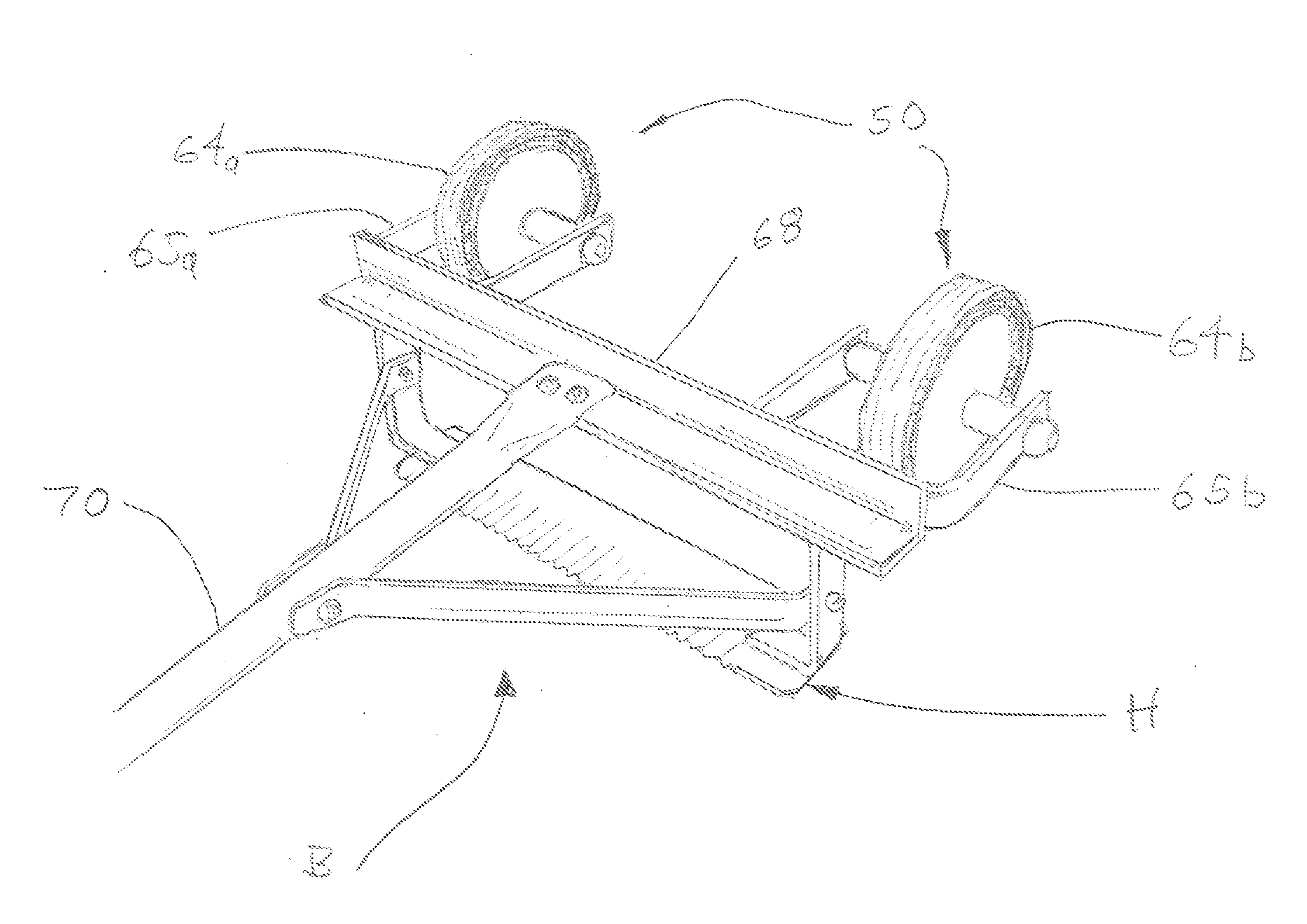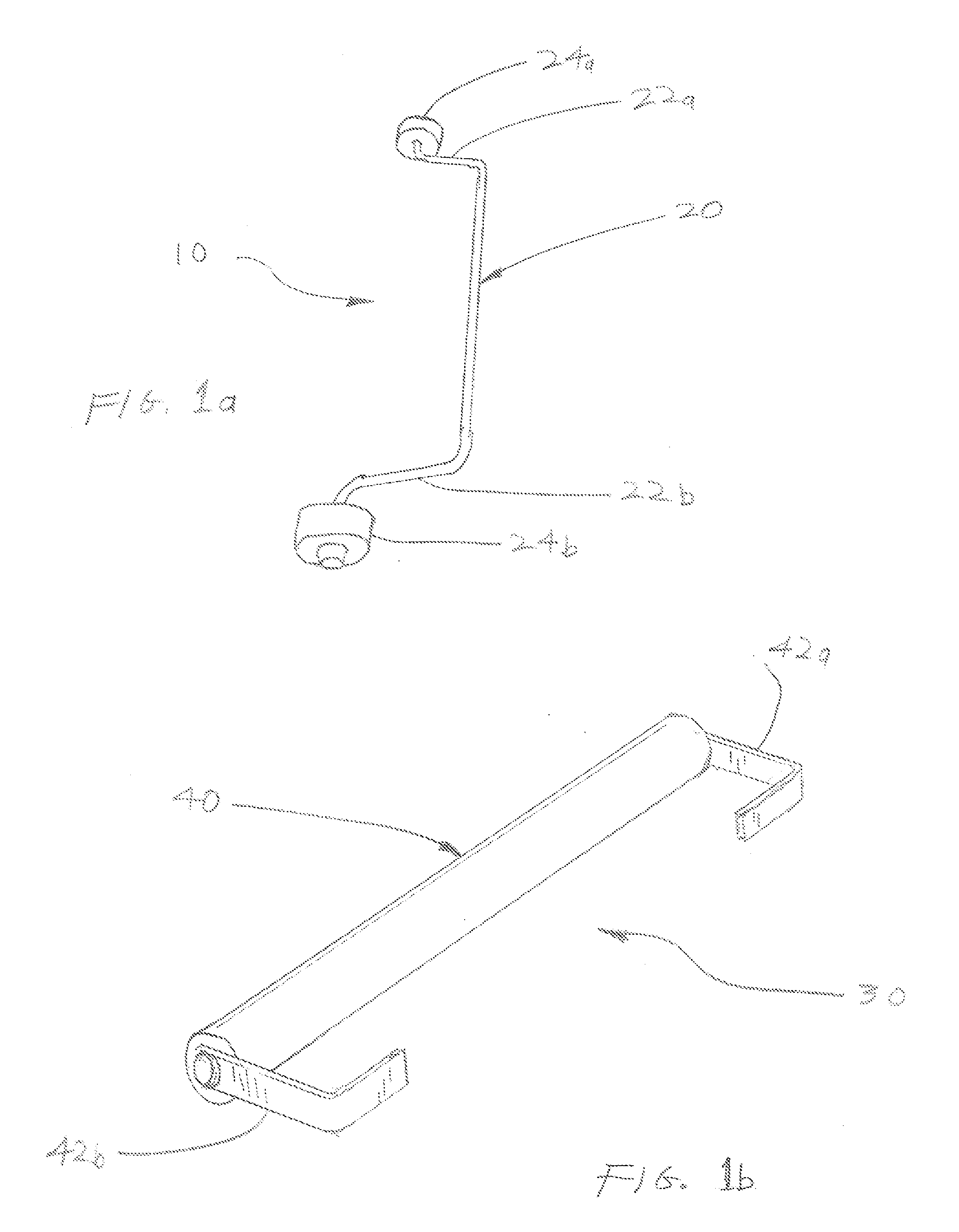Leverage device for hand tools
a technology of hand tools and levers, which is applied in the field of levers for hand tools, can solve the problems of time-consuming and time-consuming tasks, many implements are vulnerable to inconsistent production, and it is difficult to use any of these tools, so as to achieve a greater range of use of tools, improve the use efficiency, and improve the effect of operation speed
- Summary
- Abstract
- Description
- Claims
- Application Information
AI Technical Summary
Benefits of technology
Problems solved by technology
Method used
Image
Examples
embodiment 50
[0050]In FIG. 2a, the preferred embodiment 50, much like that of OSS 10 in FIG. 1a, but with two larger wheels 64a and 64b, attached by two large U-shaped brackets 65a and 65b, in turn said brackets are attached to cross member 68, which in turn is attached to handle 70 of hoe B. Head assembly H of hoe B is like any common variety of hoe used for upturning soil when preparing for planting, or as may be used for de-weeding and so on. As illustrated, OSS 50 is in an outboard location several inches behind hoe E. This distance may vary depending on the type or size of tool being used and the application. In most relatively common uses and applications, the distance would be about 4″ to 7″ out from the cross member 68.
[0051]In FIG. 2a hoe B with the preferred embodiment OSS 50 attached, is able to easily upturn dirt D and at a consistent depth shown as line L. With OSS 50 hoe B has several substantial advantages. First, it maintains an even drawing when the user (not shown) pulls on hoe...
embodiment 30
[0052]In this particular application with the use on a hoe, the type of OSS used, either with wheels as illustrated or like the preferred embodiment 30 in FIG. 1b, the outcome is feasible, but the larger wheels in OSS 50 make it easier.
[0053]In FIG. 3a, the preferred embodiment 30 in FIG. 1b has been attached to a garden rake R. As illustrated, the two outboard extensions 42a and 42b have been attached to rake R by fasteners 46a and 46b, thus placing stabilizer roller 40 outboard (outward) from rake head H. As illustrated the distance between stabilizer roller 40 and rake head H may depend on the type of rake being used and the application. In most relatively common garden uses and applications with a rake, the distance would be about 3″ to 5″ outward from tines T in rake head H.
[0054]In FIG. 3a rake R with the preferred embodiment OSS 30 attached is able to rake a surface S with several substantial advantages. First, it maintains an even drawing when the user (not shown) pulls on r...
embodiment 10
[0055]While it may be acceptable to use an OSS with wheels such as the preferred embodiment 10 illustrated in FIG. 1a, there is another particularly unique advantage of using OSS 30 with roller 40 as illustrated in FIGS. 3a and 3b. As illustrated in FIG. 3b stabilizer roller 40 serves not only serves as a stabilizer or a leverage device during raking, it also provides a grading function that smoothes down surface S after the raking when using the pulling process. In FIG. 3b this is more precisely illustrated with the un-raked surface U in a jagged line, raked surface V in a slightly jagged line, and with raked and smoothed surface W with a smooth liner.
[0056]In FIG. 4 grader G has an OSS 30 much like that in FIG. 1b and as used on rake R in FIGS. 3a and 3b. Grader G has one single blade B that spans the grader's entire width and is used to level out dirt, sand, gravel and the like in places such as walkways, paths, playgrounds, sports fields and so on. Stabilizer roller 40 sets outb...
PUM
 Login to View More
Login to View More Abstract
Description
Claims
Application Information
 Login to View More
Login to View More - R&D
- Intellectual Property
- Life Sciences
- Materials
- Tech Scout
- Unparalleled Data Quality
- Higher Quality Content
- 60% Fewer Hallucinations
Browse by: Latest US Patents, China's latest patents, Technical Efficacy Thesaurus, Application Domain, Technology Topic, Popular Technical Reports.
© 2025 PatSnap. All rights reserved.Legal|Privacy policy|Modern Slavery Act Transparency Statement|Sitemap|About US| Contact US: help@patsnap.com



